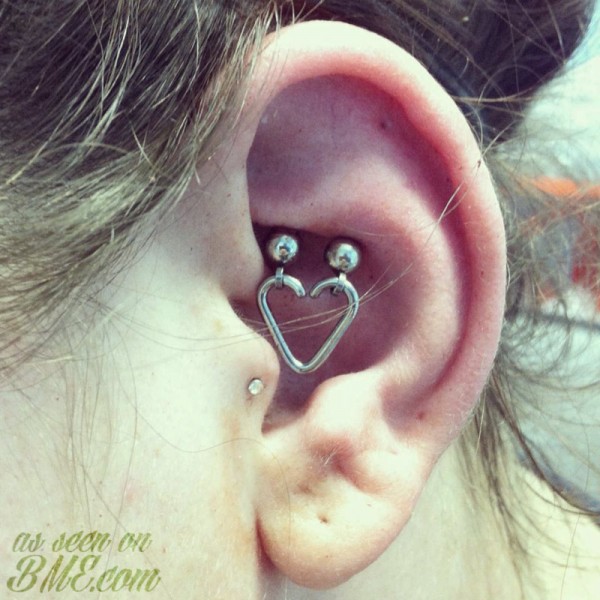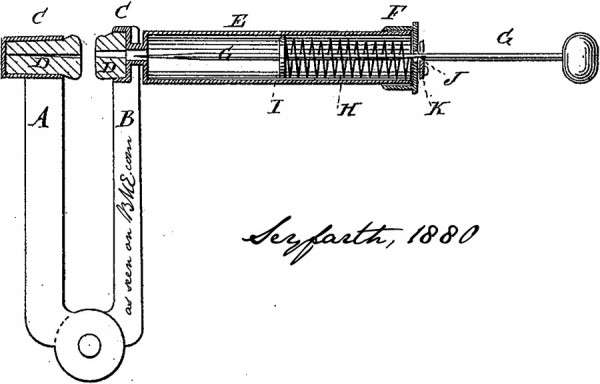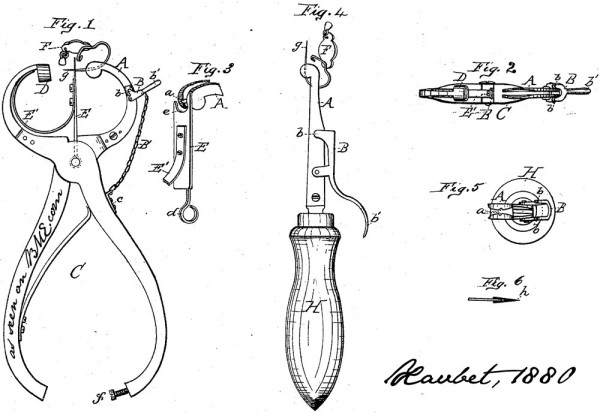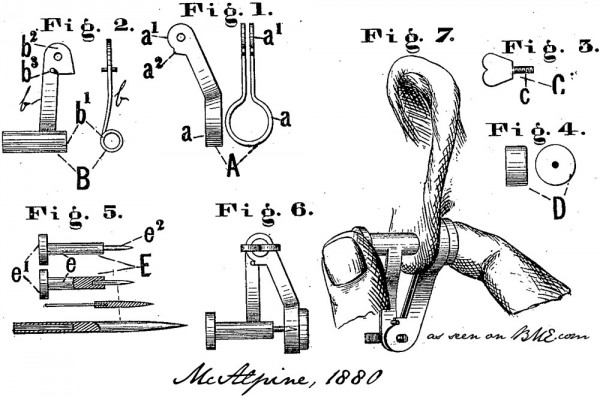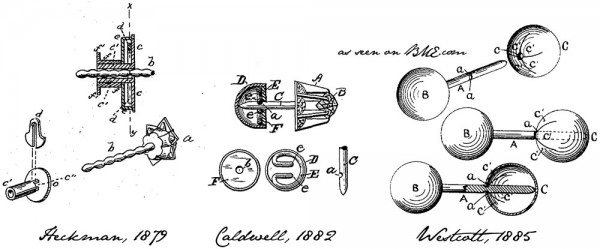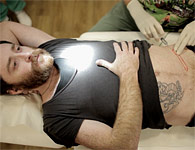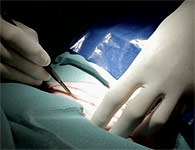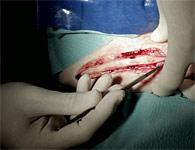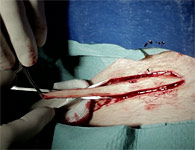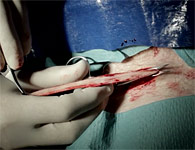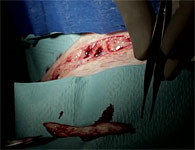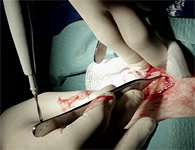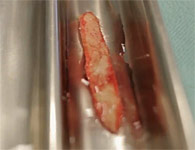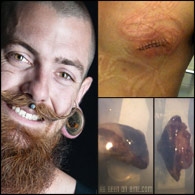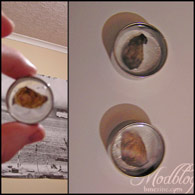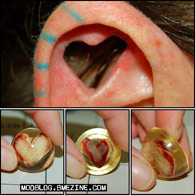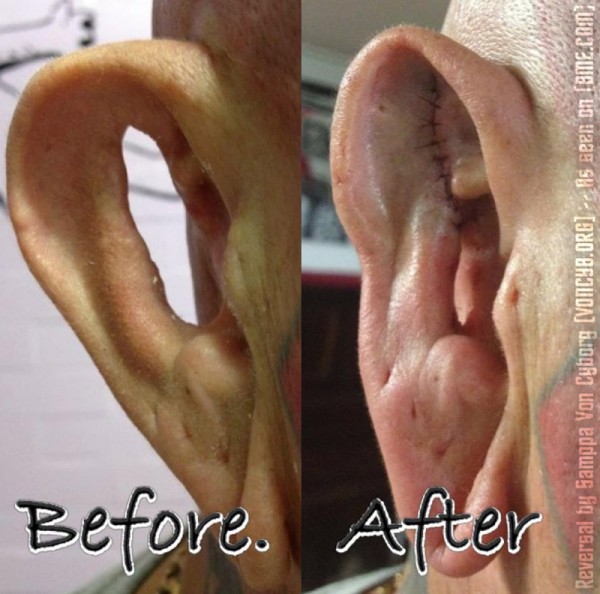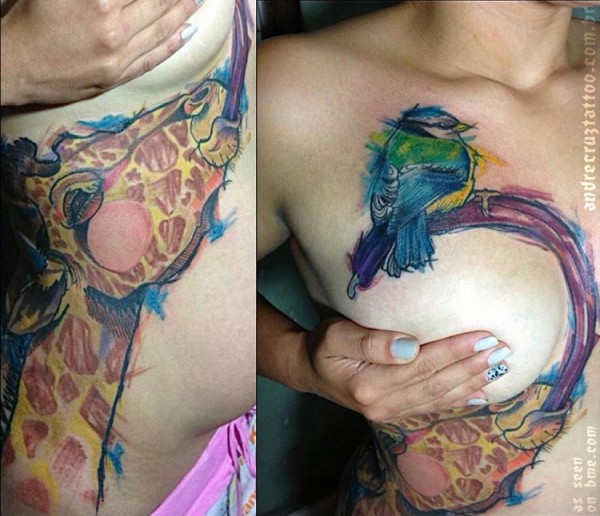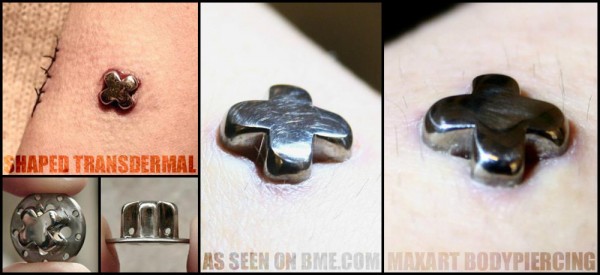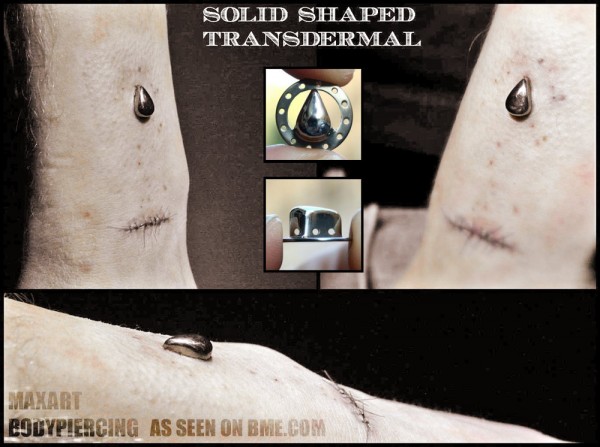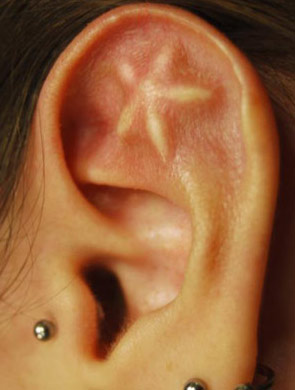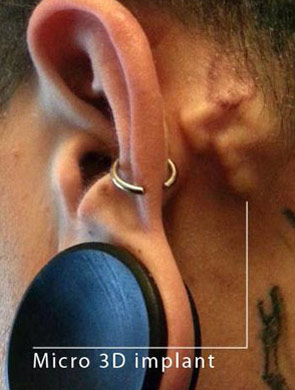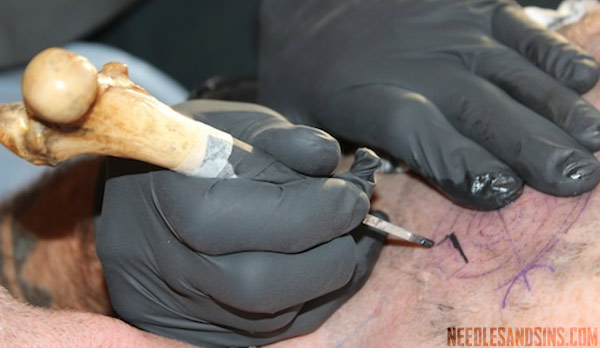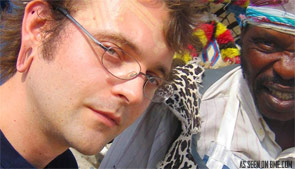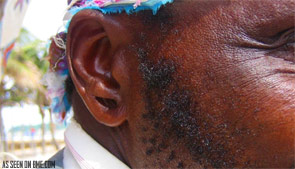Everyone has seen heart-shaped jewelry dropped into daiths over and over, but unfortunately not everyone who wants the look of a metal heart inside their ear has the anatomy to support a daith. Fathead came up with an interesting alternative, instead hanging the heart from a pair of inner conch piercings.
Monthly Archives: January 2013
Post navigation
Ear Pointing via Genetic Engineering?
Recently I got into an interesting conversation with my friend Joseph about what unique mods could be done in his ear — that’s it on the left in the photo — since it has a slightly atypical shape, almost like a pointed ear. But what really blew my mind was when he showed me a picture of his brother’s ear (that’s it on the right), which has a similar but more pronounced atypical shape. Their younger brother apparently has a similar ear as well. The even stranger part of the story is that it only affects their left ears! So what do you think? Is there a gene that we could select for that would let people be born with pointed ears? Or do you agree with my sneaking suspicion that Joseph’s parents are mad scientists that have been doing experiments on their boys? It would explain their 400 IQ and ability to bench press a car. Either way, it’s pretty cool being born with naturally “modified” ears — how funny is it that they could probably show up at a tattoo convention and get people coming up and saying, “I love your ears? Who did the work?”
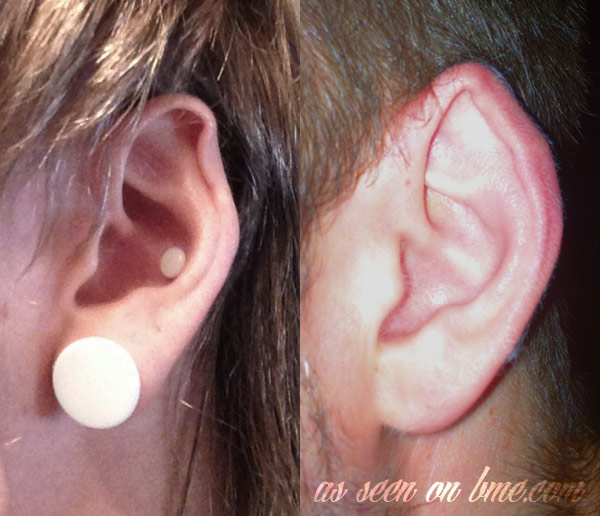
But seriously, I often think that genetic engineering is the future of human modification, once we get over our ethical hangups. It’ll never replace body modification of course because it completely removes the individual expression from the equation (since your genes are dictated by those who create you), but when it comes to really transforming ourselves, there’s not much that compares to genetic manipulation. Hell, it turned us from ape-like primates — from some sort of fish — from single-celled nothings — into the pinnacle of planetary dominance and destruction we are now. Don’t believe me? Ask Khan Noonien Singh! Bring on the Eugenics Wars! Create the Augments!
KHAAAAAAAAAAAANNNNNNN!!!
The Early History Of The Ear Piercing Gun
This morning I was reading old patents (yes, this is what I do for entertainment) and came across an interesting one from way back the last time piercing was überpopular over 130 years ago — filed May 10 and patented July 13, 1880 by Edward Seyfarth in Illinois (US Patent #240,073). As you can see, the design is not that much different from the piercing guns used by disease spreading hacks ^H^H^H^H nostril mutilating morons ^H^H^H^H I mean beauty salon “piercers” even to this day. The patent application reads in part,
“Be it known that I, Edward Seyfarth, of Lanark, in the county of Carroll and State of Illinois, have invented a new and useful Improvement in Ear-Piercers … The object of this invention is to furnish ear-piercers so constructed that the puncture can be made in exactly the desired spot and so quickly as to be painless … The invention consists in constructing an ear-piercer of a pair of bars hinged to each other at one end and provided at their other ends with sockets to receive blocks to be pressed against the ear, the tube having a cap upon its outer end, the needle having a disk and a notch, the spiral spring, and the catch for holding the needle when drawn out, so that the ear may be pierced while being compressed.”
“In using the piercer the blocks (D) are placed upon the opposite sides of the lobe of the ear in such a position that the hole through the blocks (D) will be directly over the spot where it is desired to puncture the ear. The arms (A and B) are then pressed together to numb the part of the ear between the blocks (D). The catch (K) is then drawn back to release the needle (G), which is forced forward to make the puncture by the elasticity of the spring (H), thus making the puncture without causing pain. The needle (G) is then drawn back, the instrument is removed from the ear, and a wire or thread passed through the puncture in the usual way.”
I’ve often heard the urban myth that the ear piercing gun is directly based on or evolved from the tool that places tags in animal ears — it wouldn’t surprise me if I’ve even written that at times. Even the extremely qualified and knowledgeable Elayne Angel says this in her recent book on the subject “The Piercing Bible” (which reminds me, check out her excellent piercing blog at that link), writing “these gadgets were originally invented for tagging cattle and other animals, and later adapted for use on humans”. But it seems this is a misleading statement, arguably false — at best the two tools co-evolved. More likely when we’re talking about piercing tools of the “gun” type that’s most common, one should more accurately argue the evolutionary process is actually the other way around, with a number of patents for animal tagging tools going to far as to explicitly refer back to this very ear-piercing gun patent by Edward Seyfarth! On the whole though I think it’s more realistic to say that the vast majority of animal tagging tools come from the same design family as modified pliers like riveting tools and leather punches, without that much overlap with the design of piercing guns (with a number of notable exceptions). But I’m beginning to digress.
Speaking of ear piercing guns that look more like animal tagging tools, there’s Francis X. Xavbet’s “ear piercing pliers” filed December 3rd, 1880 (US Patent #250,121 issued November 29, 1881), a simple clamp-like device. Xavbet’s design, unlike Seyfarth’s which only creates the hole, uses sharpened jewelry to accomplish the process in a single step as the tool places the ring. His patent reads in part,
“The object I have in view is to produce simple and convenient means for piercing ears, in which the ear-ring itself can be used as the piercing-point, and will be released by the instrument when the hole is formed, so as to remain in the ear till healed.”
“The ear-ring (F) … has a sharp-pointed wire (g). It is grasped by the clamp (A), in the position shown in Fig. 1, the plate (E) is then pushed toward the socket (D), and the lobe of the ear is introduced between such plate and the point of the ear-ring. The pliers are then forced together and the ear pierced, when the chain (B) draws back the dog (B) and the clamp is released. The instrument can now be removed from the ear and leave the ear-ring in position. The sharp point of the ear-ring can then be cut off; but this is not necessary, if the ear-ring is provided with a closed keeper, such as is used on safety pins.”
“When it is desired to place in the ears earrings not provided with sharpened points the removable cutting-points (h), Fig. 6, are used. These can be detached from the wires of the ear-rings after the holes are formed.”
I want to mention one other piercing tool that I dug up, filed just after the Seyfarth design by James McAlpine, on May 20, 1880 with the patent issued November 30th (US Patent #234,881). It deserves mention because it’s by far the simplest — not much more than a holder to help shove a short needle through the lobe with your thumb — he even suggests piercing both ears at once, as the tool is designed to be one-handed. The patent reads,
“The invention consists, mainly, in certain peculiarities of construction … [a] means of which the instrument is adapted for use with one hand, in consequence of which it is possible, by applying an instrument to each ear and operating them simultaneously, to pierce both ears at the same time.”
“The operation is substantially as follows: The jaws having been opened, the set-screw being loose, the bearing-faces may be adjusted to the lobe of the ear, and then be held in the proper position simply by tightening the set-screw. By means of the stop projection and pin the jaws are prevented from being brought together too closely. An instrument being thus attached to each ear, as indicated in Fig. 7, and the piercers being inserted in the tubes, the operator, by means of his thumb and finger, simply presses the piercer toward the button, in consequence of which the lobe is pierced. The hands being used simultaneously, both ears are pierced at once.”
“Some of the advantages are as follows: The use of two instruments at once for simultaneous action is desirable, because, first, a saving of time is effected, and, second, the pain and difficulty resulting from two distinct operations are avoided.”
The above designs are some of the earliest piercing tools of their respective families that I have been able to find to date — although I’m still searching and I strongly believe there are earlier ones in the patent archives that are still to be dug up. I don’t know for certain whether the first one is the earliest patent on a “true piercing gun” and whether Mr. Seyfarth can be credited as the concept’s overall inventor (I doubt it), but it’s certainly very early and you can still see its influence in ear piercing guns in use around the world.
As you may have noticed from these three Victorian patents, at this point there wasn’t a standardized design for the initial jewelry such as the ubiquitous butterfly-back that is still common today. However, browsing other early patents you start to see hints of this line of thinking, and definite precursors of designs that are still in use. From left to right below are US patents 216,954 (filed May 1, 1879 by Lois Heckman), 269,383 (May 8, 1882 by John Caldwell), and 320,991 (May 1, 1885 by Charles Westcott) — what is it with piercing inspiration and the month of May by the way?
All three of these designs use some variation on the backing lightly clamping into place on the bar, the first two being aesthetically closest to modern salon-style jewelry. The third one caught my eye though, because although it is functionally similar to the first two, visually it is identical to the barbell jewelry popularized in the body piercing world by Jim Ward in the 1970s…
When I have more time I will do additional patent research on this subject, both on the early history of body modification, and on some of the more recent patents, which have the advantage of being far more hilarious. For example, I was just reading a silly patent on a line of tongue piercing jewelry that contains a receptacle to release “a substance such as a chemical, breath freshener, pleasant flavor, or medication into the mouth of a wearer” (US Patents 6,675,613 and 8,006,516). The concept works just as you’d expect — a hollow bar to hold the substance, which is then released through holes in the beads. Anyone who has ever brushed plaque off of a tongue barbell can imagine just how disgusting this jewelry has the potential of becoming!!!
Skin Removal Scarification = Profit?
Australian Israeli-born and currently Iceland-based conceptual jeweler Sruli Recht — who tends to have a wonderful sci-fi aesthetic to his fashion and design that is less silly than much of the “far out” ideas too-often presented by his field — recently had a roughly 1/2″ by 4″ strip of skin cut off his belly which was then tanned and wrapped around a 24k gold ring, now being offered for a half million dollars. The somewhat grotesque design doesn’t just look like random leather — it’s even got wiry belly hair. He calls it the “Forget Me Knot”. Recht has lots of experience working with dubious organic materials — animal and fish remains including a stillborn lamb, hair, spider silk from a modified goat — but this is the first time he’s used human skin.
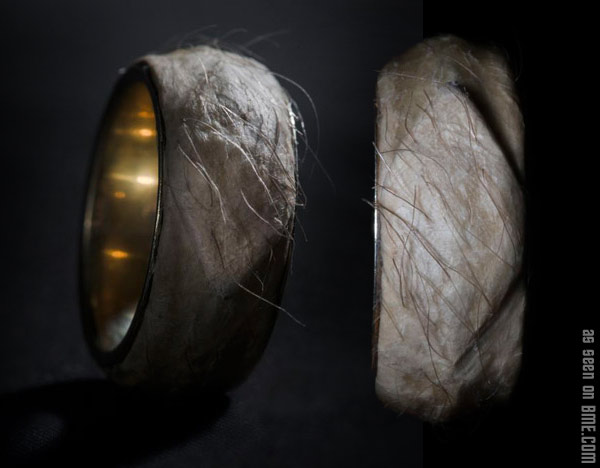
Here’s a graphic YouTube video of the procedure and some stills from it. The procedure is actually quite fascinating if you’re more used to the sort of skin removal scars done in the body modification world where the concern is the scar, rather than the excised tissue. You’ll see the doctor first spend a surprisingly long time anesthetizing the area, then cutting the outline using a scalpel, and then quickly cutting off the strip of skin using a pair of surgical scissors. Next you’ll see an interesting use of an electrocautery tool to stop small bleeders, where instead of applying the electrocautery tool to the wound itself, the vessels are pinched using tweezers, which are then electrified. Finally the wound is sutured closed.
Recht’s work is in a way another example of the “fine art” world catching up to and borrowing from the body modification world (Recht is no outsider though, and has tattoos as well as large gauge inner conch piercings), which has been using procedure remnants in jewelry for ages. Here are a few examples formerly featured on BME — a couple examples of removed nipples encased in cast acrylic resin (this seems to be a trend!), and a heart-shaped piece of human skin and cartilage inside a set of earplugs, also cast in clear resin. Below the pictures are a list of the previous entries that cover them in more detail.
- Nipple plugs #1: Mustache March and Guess What
- Nipple plugs #2: Grossest Plugs Ever
- Ear-heart plugs: Heart-shaped Ear Cartilage Preserved in Resin and Heart-shaped Cartilage Removal
PS. If anyone wants a strip of my belly skin — I have plenty of it, more than I need — I’ll sell it to you for a hell of a lot less than a half million dollars!
Mega-Conch Removal Reversal
Those with very long memories may recognize the ear in this photo, because it was featured on ModBlog in the 2008 interview with Howie/LunaCobra (click here to see it then). Initially the customer wanted one of the most radical conch removals, creating a hole that encompassed not just the inner conch (primarily the cymba, the upper half), but the outer (a good chunk of the triangular fossa and the anterior crus of the antihelix or “rook ridge”) as well. Howie expertly accomplished this, and it healed nicely and the customer seemed happy with it for years. But as with many procedures — as you’ve seen with the deluge of tattoo removals and lobe stretching reversals — tastes change, and the customer decided to have the procedure partially reversed to build a more normal (and more structurally stable) ear.
As regular readers know, when it comes to body modification reversals, there are few people more capable than Samppa von Cyborg (voncyb.org). I’ve seen conch closures in the past (here’s one by Quentin), but this is definitely the biggest to date, and anything bigger might not be possible. I’d say this ear is at the edges of what can safely by rebuilt short of growing new tissue (possible, but out of the reach of the bodmod community for now), and Samppa has very successfully put it back together. Reversing some procedures isn’t too hard — lobe stretching reversals tend to be universally successful — but when you start talking about procedures built around amputating tissue, it gets harder and harder. I hope that modified people, especially young people, take a very hard look at the fact that more and more and more procedures are starting to be reversed, and spend more time considering whether they really want to jump into procedures that are difficult to reverse — as I’ve commented before, the potential permanence is one of my big worries about eyeball tattoos.
Either way, nice work in these photos by both Howie (lunacobra.net) on the initial ear, and later Samppa (voncyb.org) on the reconstruction.
F-ing Birds!
It feels like it’s always the same… All you wanna do is lick a boob, and then — BOOM! — some damn bird decides to roost on your tongue. This moment in frustration immortalized by Andre Cruz Tattoo (andrecruztattoo.com.br).
The Shaped Transdermals of MaxArt
As I’ve mentioned before, Gabriele of MaxArt Body Piercing in Italy has been creating innovative shaped transdermals (to say nothing of his invention of the Skin Tunnel invention), starting with a cross-shaped one, and most recently a teardrop shaped one. Let me update you on the cross-shaped one first. I have to admit that I expected the skin to retract — I didn’t think this would be successful. But much to my surprise, even at three weeks in (which is when the two larger shots were taken), the skin rather than retracting, seems to be pulling in toward the implant. This is most likely due to Gabriele’s design decision of cross-drilling the transdermal (which you can see in the shots of the jewelry).
Most recently Gabriele has done a tear-shaped one as well, another piece of great design. Obviously some of these aesthetics can also be accomplished by putting shaped beads on normal transdermals, but these are much more powerful on closer inspection. Now all we have to wait for is the cheap knockoffs of his design — I’m already seeing horrendous clones of his skin tunnel that have none of the beautiful high-quality titanium machining that is typical of Gabriele’s transdermals and Skin Tunnels (manufactured by Veleno Web).
Micro-Implants by Dysmorphic
This star is one of the bigger ear implants that I’ve seen — you really couldn’t push its diameter much bigger without potentially running into problems. The topographically sculpted silicone star is about 15mm across, which was the biggest implant that Erwan of Dysmorphic in Lyon, France could fit in the location. The other implant pictured below, the question mark placed behind the ear, is also custom carved, as are all of Erwan’s micro-implants. Click either for a closer look.
Hand-Poked Cremation Ashes Tattoo
Former BME columnist Marisa Kakoulas at Needles and Sins just posted a fascinating article on a hand-poked cremation ashes tattoo done in a hand-poked dotwork style by Colin Dale of Skin & Bone in Copenhagen. Colin recently tattooed his friend Eric with Eric’s father’s ashes, mixed with soot to darken the ink, milled together in strong Vodka — apparently human ashes are very light and it helps to add an agent to make the tattoo more visible. Click the picture to visit Needles and Sins for the whole story.
Encounters in Africa
This photo is from two years ago when Florian and his girlfriend were in Kenya. On their way back from a safari they passed a Maasai village, where they decided to stop. This was their first reaction when they saw him and his stretched ears — perhaps the first time they’d seen a white guy with stretched ears, a practise that is all but dying out in their own culture. A very fun, friendly encounter that saw them dancing together not long after.

His picture reminded me — when Rachel and I were in Africa (an amazing experience) in 2004, in Durban we bumped into an older Zulu that made his living taking photos with tourists. As you can imagine he was a bit beat down by life, unsurprising given that he’d been essentially reduced to a zoo exhibit, turned into a curiosity for visitors due to his cultural background. So there wasn’t any dancing. He did however appear happy, or at least bemused, to meet a white guy with stretched ears as well.
